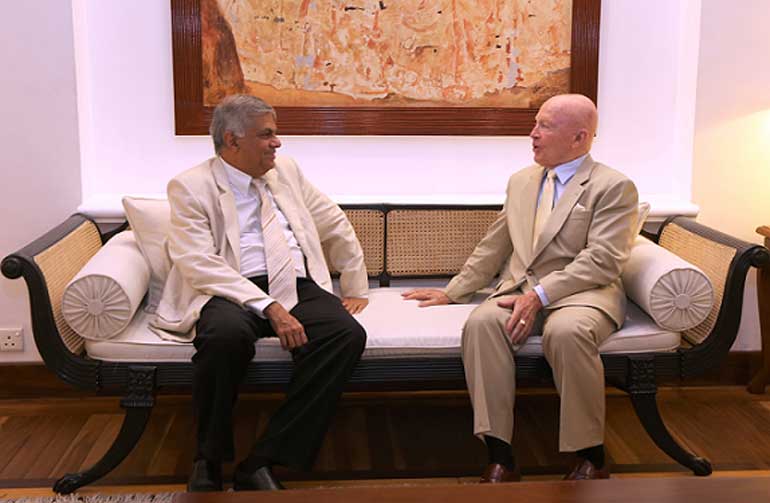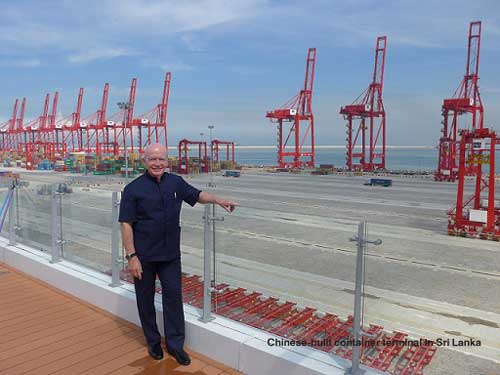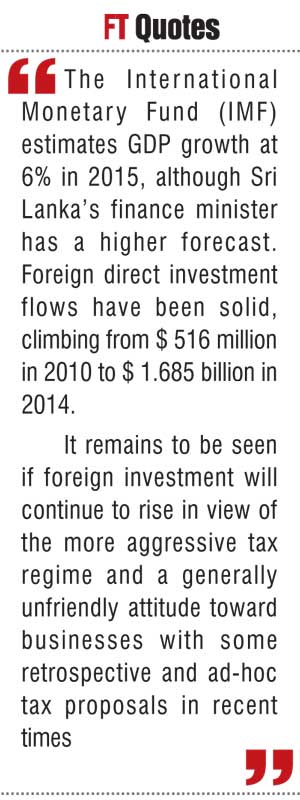Friday Jan 10, 2025
Friday Jan 10, 2025
Monday, 21 December 2015 00:00 - - {{hitsCtrl.values.hits}}

Meeting with Sri Lanka’s Prime Minister Ranil Wickremesinghe
By Mark Mobius
mobius.blog.franklintempleton.com: My team and I recently travelled to Sri Lanka and saw firsthand its great appeal as a tourist draw. We crisscrossed the country by air and by automobile, visiting a few of its cultural attractions and speaking with officials there. Along the way we gained a better understanding of the people and the business climate.
While my previous blog focused on our travel experiences as we visited a few historic sites, here my team and I further explore the country’s business and political climate as we seek out potential investment opportunities.
Politics in Sri Lanka: Tempest in Paradise
The ethnic composition of Sri Lanka has had a critical impact on its political development. The Sinhalese constitute its largest ethnic group, making up approximately 75% of the total population, while Sri Lankan Tamils—some of whom came from India to work on tea plantations during the British colonial era—are the second major ethnic group at 12%.
In addition to introducing tea, which became a major export crop, the British introduced a new political culture based on a representative government. Initially, voting rights were limited to only a small part of the population and the ethnic divisions could be balanced, but when universal adult suffrage was introduced in 1931, the Tamil and other minority groups demanded equal representation to the majority Sinhalese.
Tension between the Sinhalese and Tamils resulted in a civil war. By 1983, insurgency by the Liberation Tigers of Tamil Eelam (LTTE) based in the north of the country with support from adjacent Tamil Nadu in southern India resulted in an estimated 100,000 casualties.
Finally, in 2009 the Sri Lanka Armed Forces under President Mahinda Rajapaksa defeated the LTTE and re-established control over the entire country.
In January 2015 Maithripala Sirisena was elected president, ousting Mahinda Rajapaksa with the help of the United National Party (UNP), which reached an alliance with a faction of the Sri Lanka Freedom Party (SLFP) and other smaller Muslim and Tamil parties.
Sirisena appointed UNP leader Ranil Wickremesinghe as prime minister of a UNP-led minority government and encouraged the SLFP to work with the new ruling party to pass constitutional reforms. After general elections in August 2015, the UNP emerged as the largest party, and President Sirisena reappointed Wickremesinghe.
On my recent travels to Sri Lanka, I had the pleasure of meeting Wickremesinghe, who was quite generous with his time. He was very relaxed and seemed confident about his term in office under the new government, although he recognized challenges, including the ability to get legislation passed.
Chinese Influence in Sri Lanka
Driving around the city of Colombo in Sri Lanka, the signs of Chinese involvement are very clear. We spotted a tall telecommunications tower and a beautiful, flower-shaped concert hall, both built by the Chinese.
Perhaps most important is a new Chinese-built container port right on the city seafront, which is capable of handling the world’s largest container ships. Throughout the country there are additional signs of Chinese-funded infrastructure, including excellent roads, one being a highway from the city centre to the airport.
During his 10-year term in office, former President Rajapaksa had encouraged Chinese investment and concessionary loans, which since the end of the civil war in 2009 became the foundation of the Sri Lankan economy.
Under the new government, Chinese projects have more recently come under scrutiny and have faced delays and cancellations, including a coal power plant, the south extension of the modern Chinese-built Colombo harbour, and the Colombo Port City project involving massive reclamation with plans to create a new city.
In early 2015, the Government cancelled a $ 95 million contract to upgrade the runway at the international airport at Katunayake, alleging that the domestic company selected had insufficient experience.
Ongoing investigations of suspected corruption by the previous administration could mean extensive delays and even cancellation of important projects. Ravi Karunanayake, Sri Lanka’s new finance minister, has stated every deal, decision and transaction is being scrutinised with great detail and attention.
The new administration inherited debt of more $ 25 billion to offshore creditors, amounting to around a third of gross domestic product (GDP). Interest payments are estimated to consume about 40% of government revenue, a real problem when the Sri Lankan rupee has devaluated in recent years by as much as 20%. The new administration believes that eliminating corruption and the associated economic costs should bring benefits to Sri Lanka’s economy.
Anticorruption efforts have already resulted in action not only against Chinese projects but also projects sponsored by Indian firms, and in some cases, past contracts are being cancelled or renegotiated. The government has also shown a tendency to favour local businesses, but foreign companies remain active in the country.
The importance of privatisation
After our trip to Sri Lanka, its new government announced a policy statement that included efforts to revitalise underperforming state enterprises. In recent years, the government had taken over private companies or companies that had been previously privatized with the so-called Underutilized Assets Act.
There were mixed reactions to this law; while some genuinely underutilised assets (i.e. state land leased to private businesses) were taken over, certain assets that were performing or on the path to recovery were unfortunately also taken over. Some say these  actions were politically motivated.
actions were politically motivated.
Policy statement plans called for the formation of a State Holding Corporation Limited, structured like Singapore’s Temasek Holdings, where all state-owned enterprises would be managed by experienced executives, replacing inefficient and corrupt state employees.
A Public Wealth Trust would pass on the shares of these enterprises to the people, with the treasury secretary and the central bank governor acting as custodians. Local and global investors would be invited to participate in equity in these ventures.
Other non-strategic enterprises such as hotels and hospitals would be sold. In addition, a National Pension Fund would be formed combining the Employees’ Provident Fund and the Employees’ Trust Fund.
The statement also called for converting the economy from a ‘non-tradable’ economy to a ‘tradable’ economy, since the ratio of exports to GDP had fallen to the current level of about 12%, compared with more than 30% in 2000.
Despite the huge market potential of India, it is the destination for only about 6% of Sri Lanka’s exports, with just over 1% to China and more than 50% to the United States and European Union.
The International Monetary Fund (IMF) estimates GDP growth at 6% in 2015, although Sri Lanka’s finance minister has a higher forecast. Foreign direct investment flows have been solid, climbing from $ 516 million in 2010 to $ 1.685 billion in 2014.
It remains to be seen if foreign investment will continue to rise in view of the more aggressive tax regime and a generally unfriendly attitude toward businesses with some retrospective and ad-hoc tax proposals in recent times.
Market capitalisation of Sri Lanka’s stock exchange is low and represents only 32% of GDP. In order to expand capital markets, in our view it will be necessary to carry out more privatisations of state enterprises and encourage the growth of businesses generally.
Privatisation immediately brings revenue to the state, increases productivity with more efficient management and increases tax revenue. We think this model is better than state-owned regimes in terms of driving economic prosperity.
Companies currently listed on Sri Lanka’s stock exchange include a number of conglomerates, and many go back to the time of British colonial rule. For example, an alcoholic beverage company we visited started as a part of the excise department of the British colonial government in 1913 and then was converted into a corporation in 1974.
Their key product is arrack, a liquor drawn from the coconut flower. It is believed to be one of the purest naturally derived alcoholic beverages in the world, produced through a natural fermentation process.
If you go into the coconut-growing areas of the country, you will see two ropes tying the tops of high coconut trees and the tappers walking on one of rope and hanging onto the other rope above for balance and moving from one tree to another to tap the unopened coconut flowers, stimulating the sap to drip into earthenware pots.
Another listed company is involved in fast-moving consumer goods (FMCG) such as shampoos and other personal care items, pharmaceuticals, hospitals, hotels, airline and shipping agencies. Although formed and still controlled by a family group, it represents a growing trend for family companies to be run by professional managers.
Another firm has a portfolio of business operations which includes beverages, tea plantations, telecommunications, insurance, financial services, power generation, automobile servicing and logistics, textiles, business processing operations and call-centre services, media buying and creative services, leisure hotels and beverages.
One conglomerate is the holding company for a group of companies in the retail sector. The group operates a chain of supermarkets and a department store in addition to other enterprises.
According to various estimates, only a small amount of consumer goods sales in the country are currently sold through the organized retail sector, with ‘mom-and-pop’ small-scale shops dominating the market. So, we see opportunity for organised retail chains to gain market share.
Banking
Sri Lankan banking is led by two state-owned banks but there are a number of private banks, many of which are listed on the stock exchange. Some evolved from British colonial banks or were created through mergers of smaller local banks, and a few of the largest have branch networks of over 200 branches and hundreds of ATMs.
Like their conglomerate customers, some are extending their business to Bangladesh by acquiring banks there. Interestingly, according to Sri Lankan banking regulations, no controlling shareholders are allowed, which opens the equity base to many shareholders, both local and foreign. Remittances from Sri Lankan workers overseas run at about $ 7 billion and are an important factor in the GDP and foreign currency flows for the banks.
One unique aspect of the banks is the practice of pawning gold, where gold is given by clients as security against loans. However, the risk for such lending is high and some banks suffered losses when the price of gold declined and clients did not honour their loan commitments. Some banks have entered into microfinance. One bank has acquired a microfinance firm with 125,000 sales ladies who solicit and provide small loans to housewives.
After our recent visit to Sri Lanka, we think the country has the potential to offer more and attract much larger investment, and we hope to be part of that pool. We would encourage a more favourable tax environment to attract foreign investors, without the threat of retroactive taxes. The retroactive ‘Super Gains Tax’ targets large companies deemed to be making “excessive” profits. Companies have started paying these retroactive taxes since the third quarter of 2015 and it has had adverse impacts for shareholders. Other successful Asian countries can be viewed as examples for Sri Lanka as it continues to grow and develop its economy. More business investment means more jobs, more economic activity and less poverty. We also believe a lower rate of taxation will likely lead to less evasion. Additionally, we think Sri Lanka must continue to develop and modernise critical infrastructure as well as diversify the economy. Sri Lanka has a high literacy rate, so outsourcing of certain services could be a bright spot for the future, in addition to tourism and traditional exports.
We know there is much interest in Sri Lanka as an investment destination but not only do the political and economic conditions need to be right, but shares must be readily and easily available for us to purchase, which isn’t the case right now where liquidity is low as a result of large controlling family holdings.
We are hopeful Sri Lanka will continue to progress—
and prosper.
(Source: 2002 Census of Population and Housing, Department of Census and Statistics, Sri Lanka; Sources: International Monetary Fund, Central Bank of Sri Lanka, as of 2014; Source: Bloomberg, January 2015; Sources: World Bank as of 2000; IMF, as of May 2015; Source: World Bank, 2014 data; Source: IMF World Economic Outlook database, October 2015. There is no assurance that any estimate or forecast will be realised; Source: Central Bank of Sri Lanka; Source: Market cap as of December 10, 2015 is $ 19.3 billion; Source: Bloomberg. GDP based on 2014 data; Source: World Bank; Source: Central Bank of Sri Lanka, 2014 data).
(Mark Mobius’s comments, opinions and analyses are for informational purposes only and should not be considered individual investment advice or recommendations to invest in any security or to adopt any investment strategy. Because market and economic conditions are subject to rapid change, comments, opinions and analyses are rendered as of the date of the posting and may change without notice. The material is not intended as a complete analysis of every material fact regarding any country, region, market, industry, investment or strategy).